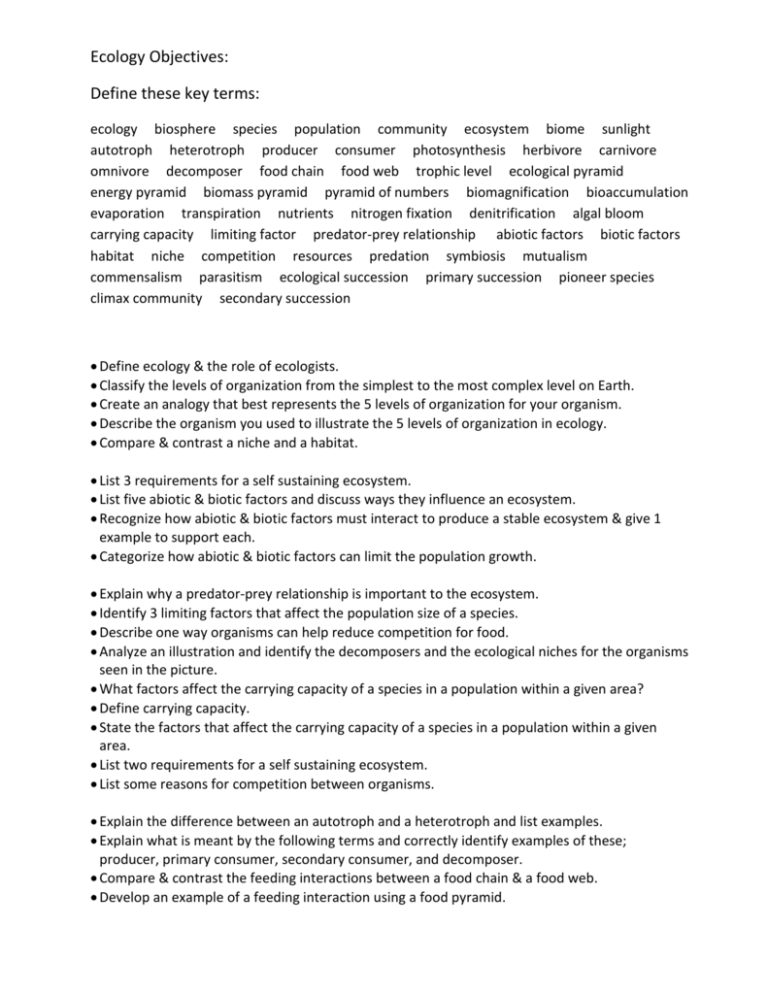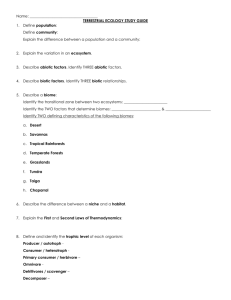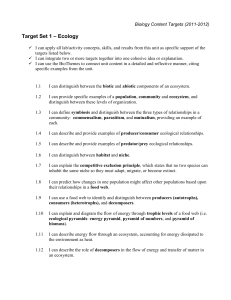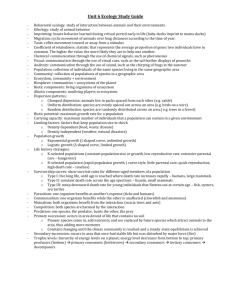Ecology Objectives: Define these key terms:
advertisement

Ecology Objectives: Define these key terms: ecology biosphere species population community ecosystem biome sunlight autotroph heterotroph producer consumer photosynthesis herbivore carnivore omnivore decomposer food chain food web trophic level ecological pyramid energy pyramid biomass pyramid pyramid of numbers biomagnification bioaccumulation evaporation transpiration nutrients nitrogen fixation denitrification algal bloom carrying capacity limiting factor predator-prey relationship abiotic factors biotic factors habitat niche competition resources predation symbiosis mutualism commensalism parasitism ecological succession primary succession pioneer species climax community secondary succession Define ecology & the role of ecologists. Classify the levels of organization from the simplest to the most complex level on Earth. Create an analogy that best represents the 5 levels of organization for your organism. Describe the organism you used to illustrate the 5 levels of organization in ecology. Compare & contrast a niche and a habitat. List 3 requirements for a self sustaining ecosystem. List five abiotic & biotic factors and discuss ways they influence an ecosystem. Recognize how abiotic & biotic factors must interact to produce a stable ecosystem & give 1 example to support each. Categorize how abiotic & biotic factors can limit the population growth. Explain why a predator-prey relationship is important to the ecosystem. Identify 3 limiting factors that affect the population size of a species. Describe one way organisms can help reduce competition for food. Analyze an illustration and identify the decomposers and the ecological niches for the organisms seen in the picture. What factors affect the carrying capacity of a species in a population within a given area? Define carrying capacity. State the factors that affect the carrying capacity of a species in a population within a given area. List two requirements for a self sustaining ecosystem. List some reasons for competition between organisms. Explain the difference between an autotroph and a heterotroph and list examples. Explain what is meant by the following terms and correctly identify examples of these; producer, primary consumer, secondary consumer, and decomposer. Compare & contrast the feeding interactions between a food chain & a food web. Develop an example of a feeding interaction using a food pyramid. Interpret the feeding levels of ecological pyramids. Describe how organisms use energy to carry on life processes. Describe how ecological pyramids are used to represent energy flow, biomass, & numbers. Explain how biomagnification can be harmful to ecosystems. Define symbiosis List three examples of symbiotic relationships. Define and provide an example for each symbiotic relationship. Explain what is meant by biomagnification and list an example of this. Explain the difference between a primary and secondary succession. Define the term ecological succession. Recognize the sequence of ecological succession for land & a pond. Discuss the water cycle & correctly include the following terms in this discussion; photosynthesis, respiration, evaporation, transpiration, condensation, excretion, & precipitation. Explain the role of photosynthesis & respiration in the carbon-oxygen cycle. Recognize the sequence of events for the biogeochemical cycle of water, carbon, & oxygen.








